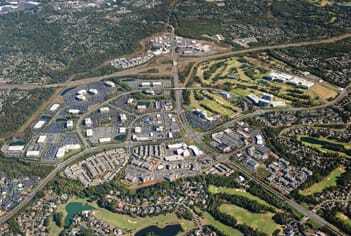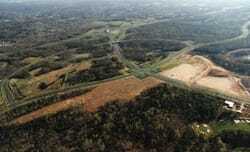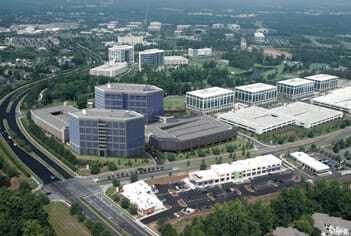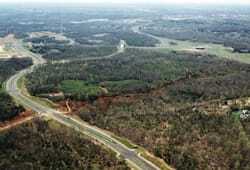How a major mixed-use development was built—on spec—despite wide swings in economic conditions.
Success was not a certainty 20 years ago when the 2,000 acres (810 ha) that were to become Charlotte’s Ballantyne community were used for hunting and farming and accessible only by hiking paths and dirt roads. Developing the property entailed substantial risk.
In 1990, Charlotte-based Bissell Companies, a collection of closely affiliated organizations in real estate development, initiated what was to be the largest entitlement process in Charlotte’s history, requesting permits for more than 5 million square feet (465,000 sq m) of office space, 500,000 square feet (46,500 sq m) of retail space, 1,000 hotel rooms, and 4,600 residential units. The plan was considered bold because at the time 5 million square feet of office space constituted the second-largest concentration of office product in the Carolinas.
In addition, the developers gambled in 1994 and 1995 by building all the main roads with associated horizontal improvements, including sidewalks, utilities, landscaping, and irrigation, for much of the 535-acre (217 ha) Ballantyne Corporate Park before even one acre was sold or developed. Bissell also committed to provide public school sites, police and fire facilities, and open detention of all water runoff in the corporate park.
The fact this was done in the wake of a recession in the early 1990s led several industry observers to speculate that the project would bankrupt the developers. In retrospect, however, by investing in elements that made the community distinctive, the developers were able to define Ballantyne in real terms rather than through marketing brochures and promises.
Skeptics overlooked several ingredients that, in time, proved to be significant factors supporting the project. Coordinating with the North Carolina Department of Transportation to have an adjacent interstate outer belt project built in 1995 was essential in establishing access, as was relocation of a state highway so it would run through the center of Ballantyne.
Demographics helped, too. In Charlotte, more than half the population lives in the southern part of the city, where Ballantyne is located, minimizing the commute for people who would work there. Also, local residents have stable incomes, which creates demand for housing and retail options. These factors stimulated development of retail, residential, hotel, and recreational space in and around Ballantyne.
In many ways, Ballantyne’s development mirrored the robust growth of the Greater Charlotte region during the past two decades. As is typical in a suburban model, housing led the way. Several communities of single-family homes were established or underway in Ballantyne within three years of its inception. Retail development, which typically follows residential, lagged, not for lack of demand but because several retail centers were already established on the project’s perimeter. However, the pace of office and hotel development has been consistently brisk.
Today, Ballantyne has about 40 office buildings comprising over 4 million square feet (372,000 sq m). Only two are build-to-suit products; the rest were built on speculation with no pre-leasing commitments. While this approach is unusual, it was consistent with the dynamic nature of the project. This bullish behavior—some might even call it reckless—has repeatedly rewarded Bissell, even in the most challenging economic times.
Bissell has always believed that having standing office product is a winning strategy. Because they are risk adverse and need to make quick decisions, companies put off commitments like leasing space until their analytics confirm the need for it. But once a decision is made, companies cannot wait through the years needed for the development process. Also, Bissell’s unified ownership of the office space allows flexibility in meeting employers’ needs to expand, contract, or relocate within the corporate park.
A commitment to always having office product available is not for the faint hearted. Since 2001, the park’s vacancy rate has fluctuated dramatically, ranging from 9 to 46 percent. The reward for such risk is reflected in the fact that today over 30 Fortune 500 companies have operations in Ballantyne. Since 2008, Bissell has leased and renewed leases for over 2 million square feet (186,000 sq m) of office space.
Bissell decided in late 2010 to build additional office space despite a vacancy rate of 26 percent, illustrating its financial strength and reaffirming its strategy of building to meet demand.
In order to attract both office and residential development, provision of retail space was important. The initial master plan called for five retail concentrations. Town Center East and West, located on the southern corners of the project’s main intersection, each contain 200,000 square feet (18,600 sq m) of space and include dining, entertainment, and other uses. Plans for the other three designated retail locations, intended to be grocery-anchored retail centers located on the perimeter of the project, have not advanced, primarily because other retail projects emerged in the surrounding area to meet consumer needs.
Ballantyne’s residential elements have largely been completed. In the late 1990s, Crescent Properties built a private country club where home prices today range from $400,000 to $4 million. Other residential communities offer more affordable housing. Ballantyne also has several apartment communities, which, like all multifamily real estate, have experienced the ups and downs of the marketplace. After initially suffering from oversupply, these products are now consistently in demand.
Today, Bissell is working on three major projects at Ballantyne Corporate Park—two speculative office buildings and a 238,000-square-foot (22,000 sq m) headquarters for SPX Corporation, a Fortune 500 company. Bissell also is planning where to locate its next speculative office project and working on two build-to-suit prospects.








